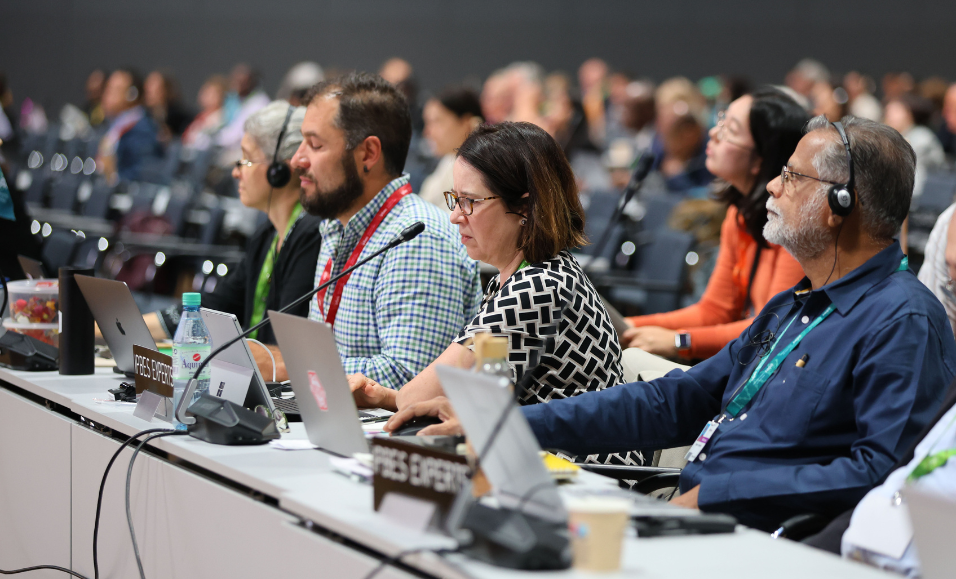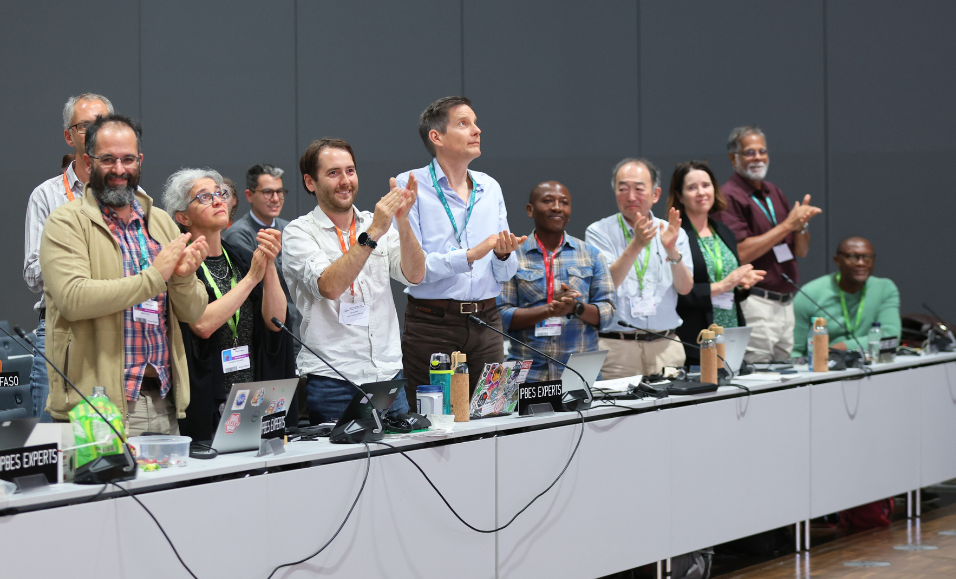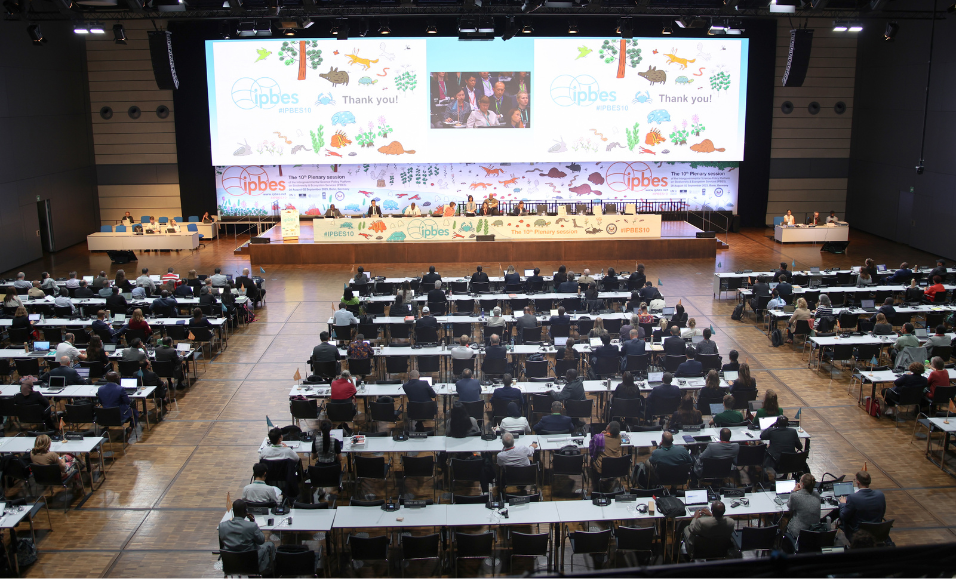Insights for Antarctica from the IPBES Invasive Alien Species Report

Professor Melodie McGeoch, Coordinating Lead Author. Credit: IPBES

IPBES experts, including Professor Melodie McGeoch, during the IPBES 10 Plenary. Credit: IPBES

IPBES Invasive Alien Species Report authors celebrating the approval of the Summary for Policy-Makers. Credit: IPBES

View of the IPBES 10 Plenary. Credit: IPBES
This year the Intergovernmental Panel on Biodiversity and Ecosystem Services (IPBES) released its first Invasive Alien Species Report. It highlights how invasive species are a significant challenge in every region across the globe, posing threats to biodiversity, the environment, economies, food security, and human wellbeing.
Invasive species have had a role in 60% of extinctions and globally cost over $400 billion a year – an amount that has quadrupled every decade since 1970. In the coming years, these impacts are only expected to increase due to trade, transport, and climate change.
Before you start feeling depressed about yet more bad news for the environment, there are solutions, and SAEF Biodiversity Theme Lead, Professor Melodie McGeoch co-led one of the two solutions-focused chapters within the report. As it turns out, the Antarctic region and its governance and biosecurity policies have many lessons to offer.
The first global Invasive Alien Species Report
Four years in the making, the IPBES Invasive Alien Species Report responds to the need to provide decision-makers with a go-to document about invasive species. The report is backed by 13,000 citations and covers current invasive species status and trends, drivers, impacts, management and future policy options for prevention and control.
As Coordinating Lead Author of Chapter 6 of the report on governance and policy options, alongside Professor Alejandro Ordonez from Aarhus University, Melodie collaborated with global experts to identify how to tackle biological invasions on an international scale.
She recently attended the international meeting in Bonn, Germany between scientists and representatives from IPBES’s close to 140 member countries to finalise and release the report. This included being part of a review process that involved around 40 hours of line-by-line clarification to ensure the report could truly be co-owned by scientists and governments.
“One of the really positive outcomes of this discussion is that there is an enhanced level of common understanding across countries about the nature of the problem and what needs to be done about it,” Melodie says.
Integrated environmental governance
Biological invasions are a complex challenge because they intersect with many sectors of society and other environmental problems, such as trade, transport and climate change, and it requires action across all levels of government to solve.
Melodie says that for those reasons it requires a solution that is designed to deal with this complexity.
The chapter she co-led on policy options proposes the approach of “integrated governance”. It is a framework that involves the implementation of well-resourced, coordinated and sustained strategic actions, and close collaboration across sectors and countries.
The chapter identifies seven strategic actions and makes the case that there is no point in implementing them independently; the approach will only work if all actions are implemented in a coordinated way at multiple levels, from local councils to international forums.
As Melodie explains, the most pivotal is at a national scale, where countries need to develop strong biosecurity strategies and action plans to implement these seven strategic actions in a way that is relevant to them.
“The mechanism that guides and tracks implementation at local and national scales, should also then feed into international processes, such as international conventions, that are relevant to the prevention and control of biological invasions,” she says.

Infographic on the principles of integrated governance from Chapter 6.
A context-specific integrated governance approach to biological invasions is enabled by a governance system with properties that support integration, and a set of strategic actions that together are designed to bring about the progress needed to meet national and international goals and targets for biological invasions. Integrated governance is rooted in four essential properties of governance systems (tree roots) that support the strategic actions (branches) to be achieved. Together, the properties and actions will bring about the step change needed for effective and sustainable management of biological invasions. Integrated governance for biological invasions reinforces the enabling conditions identified as necessary to fulfil the 2030 mission of the Kunming-Montreal Global Biodiversity Framework. An integrated governance approach activates specific strategic actions that promote transformative change to meet the goals of preventing and controlling biological invasions.
Strategic actions are:
- Enhance coordination and collaboration across international and regional mechanisms.
- Develop and adapt effective and achievable national implementation strategies.
- Share efforts, commitments and understanding of the specific roles of all actors.
- Improve policy coherence.
- Engage broadly across governmental sectors, industry, the scientific community, Indigenous Peoples and local communities and the wider public.
- Support, fund and mobilise resources for innovation, research and environmentally sound technology.
- Support information systems, infrastructures and data sharing.
The proposed strategic actions are enabled when the system-wide properties of governance (roots) are robust, equitable and inclusive, responsive and focused on effective implementation. The numbers of the branches do not imply ranking.
Lessons from Antarctica
Dr Rachel Leihy has recently returned to SAEF as a research fellow based at Monash University. She contributed expertise to the report on the threat and impact of invasive species in the sub-Antarctic and Antarctic region, as well as insights into the region’s governance structures and biosecurity policies.
Antarctica has a unique system of governance as a result of the Antarctic Treaty System. The Treaty states that “in the interests of all mankind that Antarctica shall continue forever to be used exclusively for peaceful purposes and shall not become the scene or object of international discord ”. In practice this means all Treaty Parties meet annually to consult and make decisions in the best interests of the region.
Much of the decision-making related to the environment is supported by the Scientific Committee for Antarctic Research (SCAR) and the Committee for Environmental Protection (CEP). Their work is guided by the Protocol for Environmental Protection (1991) which among its principles prohibits the introduction of non-native species.
Collaboration across countries and sectors working within the Antarctic Treaty System has contributed to integrated biosecurity processes and policy. For example, the Non-Native Species Manual developed by the CEP provides practical guidance to Treaty Parties on how to prevent and manage biological invasions through their national Antarctic programs. Meanwhile, the Antarctic tourism industry body, the International Association for Antarctica Tour Operators (IAATO) has aligned guidance for its members and tourists visiting the region. As a result, considerable progress has been made to ensure best practice monitoring and management practices are in place to prevent biological incursions in the region.
“By contrast, the situation in the sub-Antarctic is much more varied depending on which nation is responsible for which area of the continent or island. That means there have been quite different biosecurity procedures across different places and that has played out into different invasion patterns,” Rachel says.
On many sub-Antarctic islands, there has been a long history of introduction of invasive species. Invasive predators such as cats, rats, and mice, have had devastating impacts on native biodiversity, and rabbits and reindeer have caused extensive damage to vegetation. Introduced invertebrates have also caused the decline of native invertebrates.
“In many cases this has dramatically changed the abundance of the unique species on these islands that in many cases aren’t found anywhere else,” Rachel says.
In recent years, there has been an increasing emphasis on biosecurity policy and eradication programs across the sub-Antarctic. On Macquarie Island, which falls in Australia’s jurisdiction, integrated biosecurity policy has seen rats, rabbits, and mice successfully eradicated in 2014 and the recovery of vegetation.

Dr Rachel Leihy

The last sheep on Marion Island in 1978. Credit: Valdon Smith, Antarctic Legacy of South Africa Archive

The last tree planted on Marion Island as part of an unsuccessful experiment to creative wind-breaks in 1952. Credit: Nic Van de Merwe, Antarctic Legacy of South Africa Archive
Collaboration to protect the planet’s last great wilderness and beyond
“The Antarctic shows us that even the most remote parts of this planet are affected by biological invasions, and even the most remote parts of the planet are going to continue to be affected not only by ongoing and growing trade, transport, and tourism, but also because of climate change,” Melodie says.
Alongside its biosecurity policies, Antarctica has been protected by its comparative isolation and extreme climatic conditions—low temperatures, low water availability and high winds—which many invaders are unable to survive. However, climate change is causing the region to become more environmentally suitable for different species and there is a risk that the number of species that could potentially establish will increase.
“On the Antarctic continent itself there are still few invasive species and it remains a really pristine ecosystem where its communities haven’t yet been modified by human influence. Globally that is really rare and important,” Rachel says.
If we want Antarctica to remain this way, it is imperative that the recommendations of the IPBES Report are implemented. National governments must take the lead in implementing the principles of integrated environmental governance and continuing to collaborate on management strategies and robust policy. If this happens in every region across the the globe, we’ll see benefits from Antarctica to the ecosystems and communities on our own doorsteps.
Read more
McGeoch, M. A., Ordonez, A., Howard, P. L., Groom, Q. J., Shrestha, B. B., Fernandez, M., Brugnoli, E., Bwalya, B., Byun, C., Ksenofontov, S., Ojaveer, H., Simberloff, D., Mungi, N. A., and Rono, B. (2023). Chapter 6: Governance and policy options for the management of biological invasions. In: Thematic Assessment Report on Invasive Alien Species and their Control of the Intergovernmental Science-Policy Platform on Biodiversity and Ecosystem Services. Roy, H. E., Pauchard, A., Stoett, P., and Renard Truong, T. (eds.). IPBES secretariat, Bonn, Germany. https://doi.org/10.5281/zenodo.7430747
IPBES (2023) Thematic Assessment Report on Invasive Alien Species and their Control of the Intergovernmental Science-Policy Platform on Biodiversity and Ecosystem Services. Roy, H. E., Pauchard, A., Stoett, P., and Renard Truong, T. (eds.) IPBES secretariat, Bonn, Germany. https://doi.org/10.5281/zenodo.7430682